Cow-sheep Hybrids
Mammalian Hybrids
|
Moreover, there are calves born with lamb's tails, and lambs with the tail of a calf.
—Ulisse Aldrovandi Monstrorum Historia‡ |
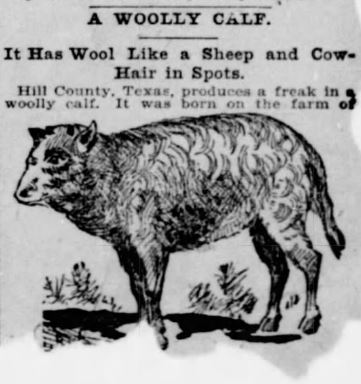 A cow-sheep hybrid (Post-Dispatch St. Louis, Jun. 28, 1896, p. 29)
A cow-sheep hybrid (Post-Dispatch St. Louis, Jun. 28, 1896, p. 29)
The evidence for cow-sheep hybrids is sparser than that available for some crosses that what would otherwise seem less likely, say, sheep × pig or dog × cow. But a good many reports do exist. Christiansen (1952) pictures an alleged hybrid, and Mohr (1930) reports a sheep-cow calved in the town of Husum in northern Germany (see also: Wittmer 1925). And Slavik et al. (1997) successfully produced cow-sheep hybrid embryos by fertilizing bovine oocytes with ram semen in vitro. But goat-sheep hybrids, are much more common.
There are also old news reports about sheep-cow hybrids. Under the heading of Brief State News on page 19, column 3, of the May 3, 1917 issue of The Ward County independent, a newspaper published in Minot, North Dakota, the following notice appears (source):
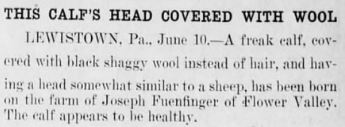 Above: A notice in the San Bernardino, California, News (Jun. 10, 1914, p. 1; ||y2mdu8lh)
Above: A notice in the San Bernardino, California, News (Jun. 10, 1914, p. 1; ||y2mdu8lh)
Another report about such an animal appeared in the Washington, D.C. Evening Star (Sep. 20, 1925, p. 26, col. 1):
RARE FREAK OF NATURE
Hybrid Offspring of Cow and Ram
Found in Prussia
ROHNENSAND, Prussia, August 28.—A cross between a cow and a sheep in this district has been a source of much scientific and popular conjecture during the past year. The mother of this extraordinary freak of nature was a black cow weighing 495 pounds, and the father a white ram of 176 pounds. The hybrid offspring of these strangely mated parents is the property of Herr Thomsen, the landlord of the village inn. The animal is considerably smaller than an average sized calf, but it has the body of a cow. It has a sheep’s head and tail. The horns are curved like those of a ram and the coating of the animal resembles lamb’s wool.
De Graafschap-bode (Mar. 14, 1924, p. 3a; ||ycr6oyz9) reported a cow had given birth to an offspring with the body of a calf, but "the head of a sheep fully covered in wool." The Kingston Daily Freeman ( Mar. 9, 1903, p. 7; ||mrwrpupw) reported that “A cow belonging to C. D. Mickle of Guilford Center recently gave birth to a calf which is covered with wool like a sheep.” And the Little Falls Herald (Little Falls, Minn., Mar. 18, 1904, p. 2d; ||ycxacbsh) reported that “A Lacrosse, Wis., Farmer thinks he has a fortune in the shape of a freak calf which is half cow and half sheep. The calf is two weeks old and black and white in wool, the black portion being of a sheep, while the white is the ordinary hair of a cow.”
Another report about a cow-sheep hybrid appeared in the Brattleboro, Vermont Phoenix (Oct. 14, 1892, p. 4, col. 2):
Both Chesterfield and Hinsdale are New Hampshire towns across the Connecticut River from Brattleboro.
Another notice appeared in the Omaha, Nebraska, Daily Bee (May 6, 1884, p. 7, col. 4):
Remarkable Calf
One of our country friends is the jubilant owner of a calf that throws four-legged chickens and such other curiosities into the obscurity of a dim and distant shade, and gives a backset to almost anything in the monstrosity line that we have yet heard of. On the 27th of March a cow, the property of L. A. Hipp, who lives about six miles north of this city and near the Arlington Gold Mine [this mine was in Mecklenberg, County, North Carolina], gave birth to a large male calf which is entirely destitute of hair. Its skin has a feathery appearance and somewhat resembles that of an elephant, and although now more than two weeks old, shows no indication of producing the usual hirsute covering. As to color and marking, it closely resembles its mother, the skin being red on its back and sides, while its head and legs are white. Another peculiarity is that its head, legs and feet are those of a sheep, and about three inches of its tail is adorned with wool.
And another appeared in the Patriot (Greensboro, N.C., Jun. 12, 1852, p. 2, col. 6):
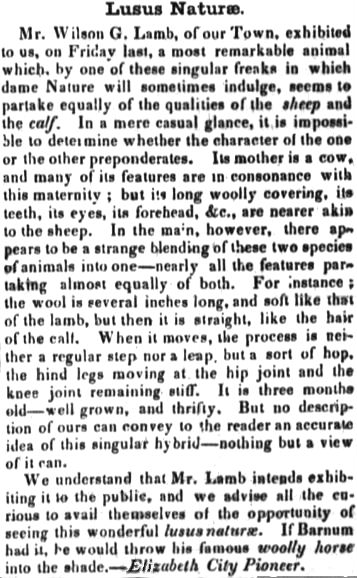
Innsbrucker Nachrichten (Innsbruck, Nov. 5, 1891, pp. 3-4; ||53tp3m4c) stated that in Wilten, a neighborhood in Innsbruck, a certain Josef Harter was in possession of an animal with the head of a calf and the body of a sheep.
La Dépêche Bretonne (Rennes, France, May. 28, 1898, p. 1b; ||2p9ev3uc) reported that a cow at Bazoge (Sarthe) had calved an animal with two heads, one like a calf's, the other like a lamb's. A quarter of a century later, also in France, another such animal (with both a calf's head and a lamb's head) was reportedly calved at Villaines-les-Prévôtes (Le Bien Public, Dijon, France, Sep. 16, 1927, p. 4e; ||ytra6b2u). And three years after that, another French animal having a calf's head and a lamb's head on a single neck, was produced by a cow belonging to a Mr. Livet-Orly a resident of La Suze-sur-Sarthe (L'Ami du Peuple, Angers, Oct. 26, 1930, p. 4g; ||4t48mr64). Each head had four eyes and one ear. At the date of the report, this double creature was doing well and nursing from both of its mouths. Another report (Le Petit Haut-Marnais, Chaumont, Sep. 4, 1931, p. 1c; ||57b7yfvw) told of a viable animal with a double, but not completely divided sheep head (4 eyes, 2 ears, 2 muzzles, 2 tongues) calved by a cow at Saint-Léger-sous-Margerie.
L'Express du Midi (Sep. 22, 1886, p. 3b; ||3uj7zu49) reported a cow giving birth at Monnaie (Indre-et-Loire) to a highly deformed animal with the head of a sheep. La Croix du Nord (Lille, Feb. 9, 1950, p. 6h; ||26rf8a57) reported a cow calving a sheep-headed calf at Saint-Léonard in the Normandy. Another animal with the head of a sheep was reportedly calved at Saint-Jean-le-Puy (Loire) in 1906 (Journal de Roanne, Jan. 7, 1906, p. 2b; ||t4tpav22). It survived two hours. Yet another French animal with a sheep's head was calved dead at Mareuil-sur-Lay (L'Ouest-Éclair, Rennes, Feb. 14, 1937, p. 4d; ||4n4mc46j). A cow on the farm of Désiré Chaillou, in Nivervile (Eure-et-Loir), bore a composite with the both the head and legs of a sheep in 1913 (Le Matin, Paris, Mar. 31, 1913, p. 2b; ||4697cf62).
Beptenoud, Isère, France. L'Express du Midi (Toulouse, Jan. 15, 1894, p. 10d; ||yc635kvt) said a cow in the French commune of Beptenoud, Isère, calved an animal with two heads, one, a calf's, the other, a lamb's.
Gonaincourt, Haute-Marne, France. A cow at Gonaincourt produced a blind calf with the nose a sheep in 1914 (Le Petit Haut-Marnais, Chaumont, Jun. 30, 1914, p. 2f; ||mwvvfmb3). It also lacked a tail.
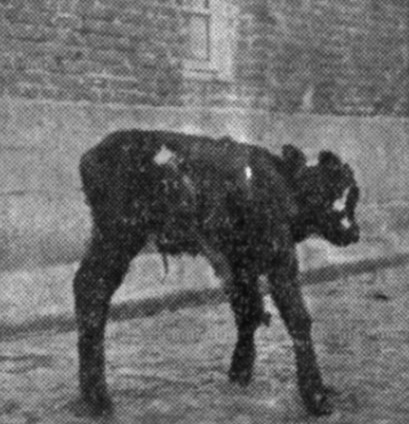 The Villers-au-Tertre cow-sheep (Le Grand Écho du Nord de la France (Lille, Apr. 12, 1936, p. 7d)
The Villers-au-Tertre cow-sheep (Le Grand Écho du Nord de la France (Lille, Apr. 12, 1936, p. 7d)
Le Grand Écho du Nord de la France (Lille, Apr. 12, 1936, p. 7d; ||bdhunjuj) said (in translation), "For the last three days, Mr. Pierre Guenez, a farmer at Villers-au-Tertre has had the freak calf shown in the photo. This calf has three normal legs and, on the rear right, a smaller leg strangely resembling that of a sheep. It also has a double udder. Despite its bizarre form, it nurses well and looks likely to live."
Le Républicain de Chinon (Chinon, Nov. 23, 1916, p. 2c; ||39pvpuwp) said a sheep-cow was on exhibit at Faubourg Saint-Jacques. According to the report, it was intersex and had two heads, two tails and seven legs.
Le Bien Public (Dijon, May. 7, 1924, p. 48; ||3ftadhd8) said "You can see, at the home of Mr. Bonavalot Foissier, at Échenon [Côte-d'Or], a two-week-old calf that is completely covered with wool. And, extraordinary as it is to say, it bleats like a sheep and is just as docile" (my translation).
One report is especially interesting because it seems to describe a bilateral gynandromorph, a very unusual condition in a hybrid. The article entitled “A CALF-SHEEP” appeared in the Fort Worth, Texas, Gazette (Aug. 20, 1891, p. 6, col. 4 & 5):
In a bilateral gynandromorph, it is thought, the initial division of the zygote gives rise to two lines of cells that follow two separate developmental pathways for the right and left halves of the body, in this case that of a sheep and that of a cow.
In Hartford, Connecticut, a cow calved a “woolly calf” with ram’s horns and a coat of black wool (Vermont Watchman and State Journal, Montpelier, Vt., Jun. 18, 1858, p. 2b; ||2cxddth6). The Boston Cultivator (Jun. 16, 1849, p. 7) reported an ovibovid calved at Cambridge, Mass., with a full coat of Merino-like wool. The Barre Patriot (Barre, Mass., Apr. 9, 1847, p. 3) reported one calved in Barre. The New Era (Clinton, Ont., Jun. 15, 1876, p. 3b; ||2bwksud9) reported another, calved at Richmond, Ontario. A cow at Waupaca, Wisconsin birthed yet another, a calf with patches of black wool (The Sun, Morris, Minn., Nov. 28, 1889, p. 1f; ||253pubyx). A French newspaper, Le Petit Champenois (Reims, Nov. 19, 1889, p. 3a; ||3r6nxkmt), reported a cow at Prangey giving birth to a woolly calf. The Crecent City Record (quoted in the Valley Record, Ashland, Or., April 9, 1891, p. 2; ||4xaspc3d) reported the calving of an animal with the fleecy coat of a sheep near Crescent City, California.
There is also an old account of a cow giving birth to two lambs and a normal calf as the result of a single pregnancy (which on its face would be a case of xenogenesis).
Cow-sheep also appear in nineteenth century listings of hybrids. For example, Morton (1847a, p. 43) offers the following account:
The source cited (Brande 1845, p. 573) states that hybrids have been produced from the union “of the bull and sheep, notwithstanding their disparity of size.” But no documenting reports are mentioned. William Thomas Brande (1788-1866), a chemist and an author of many scientific texts, was a fellow of the Royal Society (access the 1866 edition of Brande).
Q: What do you get if you cross an angry sheep and a moody cow?
A: An animal that’s in a baaaaaaaad moooooood.
And such animals were sometimes offered for sale. An advertisement the New York Clipper (Sep. 4, 1880, p. 191, col. 4; ||kxozxpv) reads as follows: “Great Curiosity for Sale. A HYBRID ANIMAL, HALF COW, HALF SHEEP, and covered with wool; has four horns—two buck’s horns on his feet. Apply to JOHN BRAGAW, Guntherville, L. I., N. Y.”
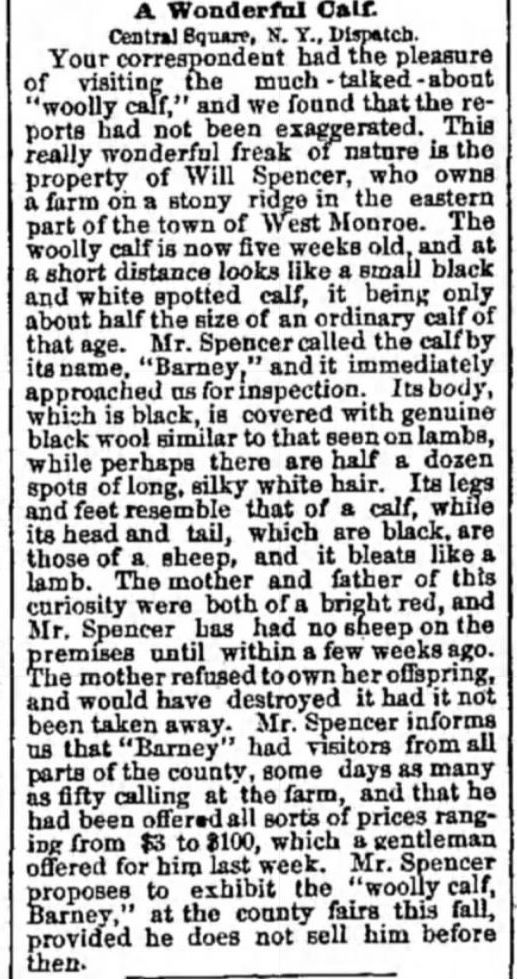 Old report about a probable cow-sheep hybrid (Source: The Milwaukee, Weekly Wisconsin, Jun. 11, 1887, p. 3)
Old report about a probable cow-sheep hybrid (Source: The Milwaukee, Weekly Wisconsin, Jun. 11, 1887, p. 3)
|
ex permistione diuersorum seminum nascitur monstrum biforme, vt vitulus cum capite arietis.
—Jean Riolan Opera anatomica vetera |
By the same author: Handbook of Avian Hybrids of the World, Oxford University Press (2006).
‡. ||y42a8erg
Most shared on Macroevolution.net:
Human Origins: Are we hybrids?
On the Origins of New Forms of Life
Mammalian Hybrids
Cat-rabbit Hybrids: Fact or fiction?
Famous Biologists
Dog-cow Hybrids
Georges Cuvier: A Biography
Prothero: A Rebuttal
Branches of Biology
Dog-fox Hybrids